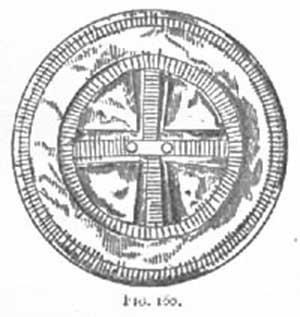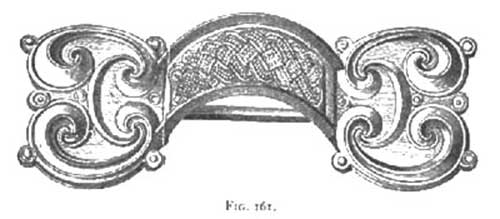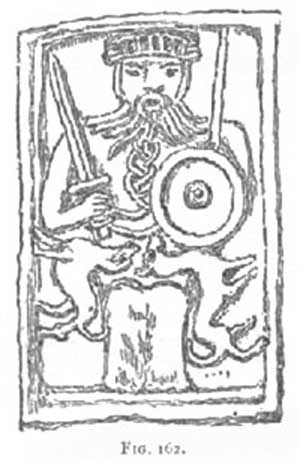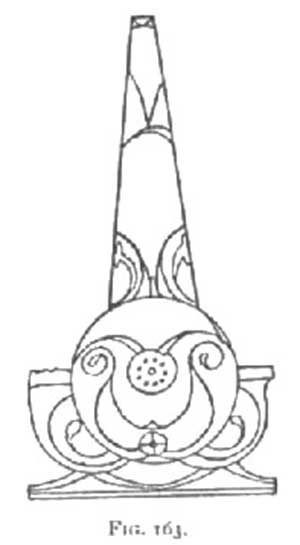Circular Gold Plates, Crowns, Diadems, etc., in Ancient Ireland
From A Smaller Social History of Ancient Ireland 1906
« previous page | contents | start of chapter | next page »
CHAPTER XVIII....continued
Circular Gold Plates.—Among the gold ornaments in the National Museum are a number of very thin circular plates, with raised ornamental patterns punched from the back, varying in diameter from 1½ inch up to 4 inches. Fig. 160 represents one of these, 3¼ inches in diameter, found near Ballina in Mayo. All of them have the two holes at the centre (shown here) for fastening on the dress.
FIG. 160. Circular gold Plate. One of those in National Museum. (From Wilde's Catalogue).
Brooches.—The brooch was worn by both men and women, and was the commonest of all articles of jewellery. It was used to fasten the mantle at the throat and was fixed crosswise. Its value—like that of the bunne-do-at—depended on the rank and means of the wearer. The poorer people wore a plain one of iron or bronze, with little or no ornamentation; but kings, queens, and other persons of high rank wore brooches made of the precious metals set with gems, and in Christian times elaborately ornamented with the peculiar Irish interlaced work. These must have been immensely expensive.
FIG 161. Specially shaped bronze Brooch: natural size: original in National Museum: pin turning on a hinge: one of the most beautiful bronze articles in the Museum, both as to design and workmanship Ornamentation on the ends produced by punching or hammering from behind. Found in a crannoge. (From Wilde's Catalogue).
That the descriptions given of brooches in old Irish writings are not exaggerated we have ample proofs in some of those now preserved in our Museums, of which the Tara Brooch figured at p. 248 is the most perfect.
The general run of brooches had the body circular, from two to four inches in diameter, with a pin from six to nine inches long, But some were much smaller, while others again were larger and longer, and reached in fact from shoulder to shoulder. These great brooches are often noticed in the records; and the Brehon Law mentions a fine for injuries caused by the points extending beyond the shoulders. As in many other cases, the records are here corroborated by existing remains; for among the collection of brooches in the National Museum are two specimens 22 and 20 inches long respectively. Brooches were made of other shapes also, of which one is represented opposite.
The usual names for brooches were delg (a 'thorn'), éo [1 syll.], cassan ('having a twisted shape'), roth ('a wheel'), and brethnas: but there were others.
The Lann, Blade, or Plate.—It was customary to wear a band or ribbon of some kind round the forehead to confine the hair. It was generally of some woven fabric; and it will be mentioned farther on that a charioteer wore a bright yellow gipne or fillet in this manner as a distinctive mark. Among the higher and richer classes the band was often a very thin flexible plate, strip, or ribbon, of burnished gold, silver, or findruine. This was what was called a lann, i.e. 'blade,' or more commonly niam-lann, 'bright-blade.'
The Minn, Diadem, or Crown.—Kings and queens wore a diadem or crown, commonly called minn: often designated minn óir, 'diadem of gold': which does not mean wholly of gold, but ornamented with gold. The minn, however, was not confined to kings and queens, but was worn by men and women belonging to all the higher classes, probably indicating rank according to shape and make, like the coronets of modern nobility. It was not worn in common, but was used on special occasions: a lady usually carried her minn-oir in her ornamental work-bag, along with other such valuable or ornamental articles, ready to be used at any moment.
The Irish minn, diadem, or crown was very expensive, and elaborately made, its value and shape being in accordance with the rank of the wearer. The body was of some fabric, probably silk or satin, adorned with gold, silver, white bronze, gems, and enamel. It was a cap made to encircle and cover the head, of which a good idea is given by the illustration (fig. 162), a representation of an Irish king, seated in state; copied from the high cross of Durrow, erected about A.D. 1010. The original crown of which this is a representation was about five inches high, quite flat on top, with a slender band all round, above and below, the two bands connected by slender little fillets or bars, about two inches asunder. It covers the whole head like a hat, and there are two bosses over the ears, three or four inches in diameter.
FIG. 162. Crowned Irish king, seated, with shield, sword, and spear: a dog on each side. (From the high cross of Durrow). Copied here from a drawing by Miss Stokes.
The Irish crown varied in shape, however. It is pretty certain that some had rays or fillets standing up detached all round. Crowns of this kind, belonging to the O'Conors, kings of Connaught, as represented in the thirteenth-century fresco-painting in Knockmoy Abbey, are shown at p. 24; and they are also mentioned in our old records. Two small objects now in the National Museum are believed to be portions—rays or fillets—of an old Irish radiated crown. One of them is figured in outline here; but this illustration gives no idea of the extraordinary beauty of the original, which is ornamented all over in richly coloured enamel. Mr. Kemble, a distinguished English antiquarian, says of these two objects:—"For beauty of design and execution they may challenge comparison with any specimen of cast bronze work that it has ever been my fortune to see."
FIG. 163. Enamelled metallic object in National Museum: believed to be a ray or fillet of a crown: half size. (From Miss Stokes).




